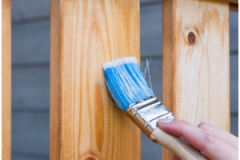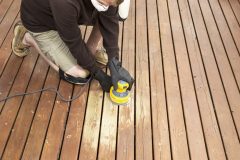
Local House Painters: Spruce Up Your Deck For Spring
Posted on March 25, 2020
The winter wreaks havoc on the exterior of your home and wooden architectural elements are no exception. Precipitation and weight sitting on the wood can cause damage and eat away at the finishes you may have applied. With the wood exposed, your deck could be at risk for mildew, mold and rot. Now that spring is here, it might be time for deck staining service. Hear DIY tips from our expert house painters.
Is Now A Good Time To Paint Your Deck?
Wood and water will never go together. The wood can be damaged just by sitting underneath water even a small amount of time can begin the breakdown process. Stains and paints will protect the wood as a first layer of defense.
To test your wood, drop several droplets of water onto the wood. If it sits on top and doesn’t soak in, you are safe for another season. If the water soaks into the wood, it’s time to consider a deck staining project.
Another tell tale sign that it’s time to restain or repaint is if the deck is older and showing signs of wear and tear. Cracks and splintered wood are signs that your stain or paint has failed and water is now getting into the wood. Some finishes will fill small cracks and hold splinters together.
Before you begin your project, there are a few items to consider.
Monitor The Temperature
 Damp wood will repel stains, making your work in vain. Check the weather and make sure your deck has a few days to dry out before you intend to paint. You’ll also want the temperature to be between 50° F and 90° F. Low humidity will allow the stain to dry faster, but avoid direct sun. The harsh rays will make the stain dry before the paint can absorb it.
Damp wood will repel stains, making your work in vain. Check the weather and make sure your deck has a few days to dry out before you intend to paint. You’ll also want the temperature to be between 50° F and 90° F. Low humidity will allow the stain to dry faster, but avoid direct sun. The harsh rays will make the stain dry before the paint can absorb it.
Prep, Prep, Prep
 To get the best results, you will want to have a clean surface to absorb stain. Take the time to sand down cracks and splinters as well as perform any necessary repairs. After, sweep the deck and use a putty knife to clean out the board joints. Invest in a deck cleaner and pressure washer to do a final wash. With pressure washing, you should wait two to three days before you attempt to paint or stain.
To get the best results, you will want to have a clean surface to absorb stain. Take the time to sand down cracks and splinters as well as perform any necessary repairs. After, sweep the deck and use a putty knife to clean out the board joints. Invest in a deck cleaner and pressure washer to do a final wash. With pressure washing, you should wait two to three days before you attempt to paint or stain.
Safety: If your deck was constructed before 2004, consult a professional before you start. Many woods from that era contain a chemical that was meant to fight rot and insects. Sanding the wood can release these chemicals into the air and soil. Pros will have options to refinish your deck safely.
Select the Best Tools For The Job
 For best results, avoid natural bristle brushes since they will lose rigidity quickly. Synthetic will work better with water-based stains. With rollers, get a short nap to create a thin layer of stain. Try a roller with ¼ inch or less in the nap. This will avoid long dry times and pooling.
For best results, avoid natural bristle brushes since they will lose rigidity quickly. Synthetic will work better with water-based stains. With rollers, get a short nap to create a thin layer of stain. Try a roller with ¼ inch or less in the nap. This will avoid long dry times and pooling.
Matchy-Match Your Paint
 It’s important to know what kind of stain is currently on your deck, since it could make your options for this stain more limited. Mixing semi-transparent, solid and clear stains will only make a mess. Solid stains are made to plug the pores of the wood, a semi-transparent or clear one is made to soak into pores. If you have concerns about what to use for your project, a pro can help with color choices.
It’s important to know what kind of stain is currently on your deck, since it could make your options for this stain more limited. Mixing semi-transparent, solid and clear stains will only make a mess. Solid stains are made to plug the pores of the wood, a semi-transparent or clear one is made to soak into pores. If you have concerns about what to use for your project, a pro can help with color choices.
More Is Not Better
 As you paint, use long, smooth strokes to cover several boards at a time to maintain color. If you are working on a larger deck that requires more than one gallon of stain, mix them together before you start painting. This will hide small inconsistencies in the colors. Try to complete one thin coat, allow full dry time, and then apply a second. More is not better. Pooling and puddles will cause the stain to flake after it’s dried.
As you paint, use long, smooth strokes to cover several boards at a time to maintain color. If you are working on a larger deck that requires more than one gallon of stain, mix them together before you start painting. This will hide small inconsistencies in the colors. Try to complete one thin coat, allow full dry time, and then apply a second. More is not better. Pooling and puddles will cause the stain to flake after it’s dried.
Call The Pros
 Ready to stain? If you have a large deck and want to consult a professional, your local house painters are here to help! Schedule a free, in-home estimate appointment with our team today.
Ready to stain? If you have a large deck and want to consult a professional, your local house painters are here to help! Schedule a free, in-home estimate appointment with our team today.





